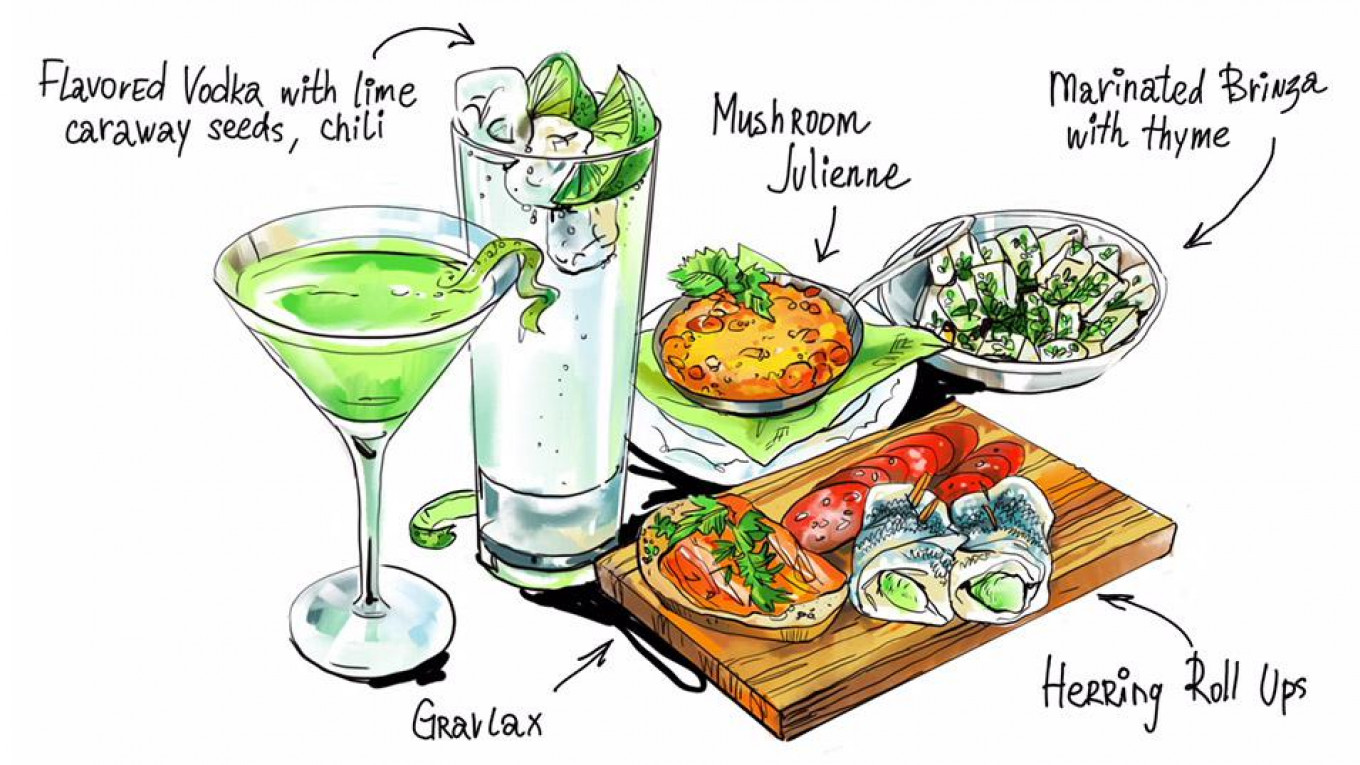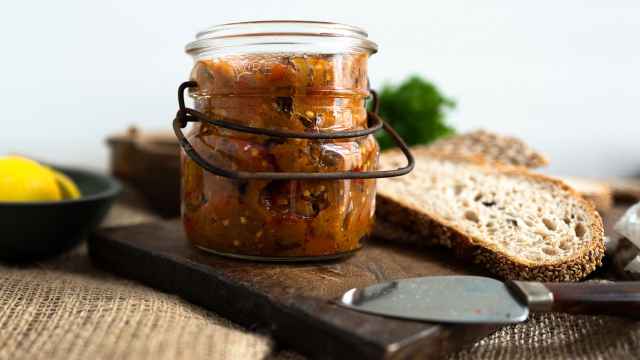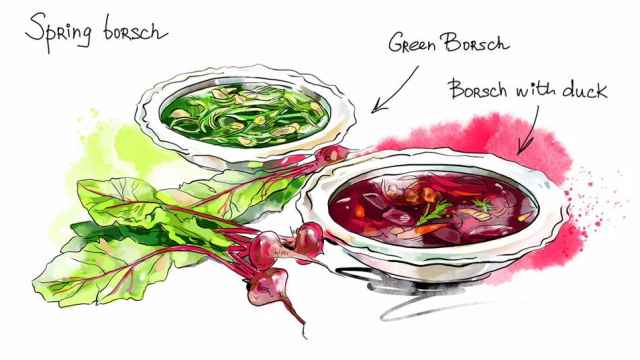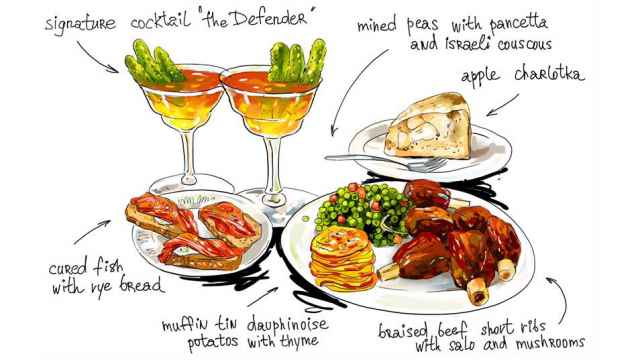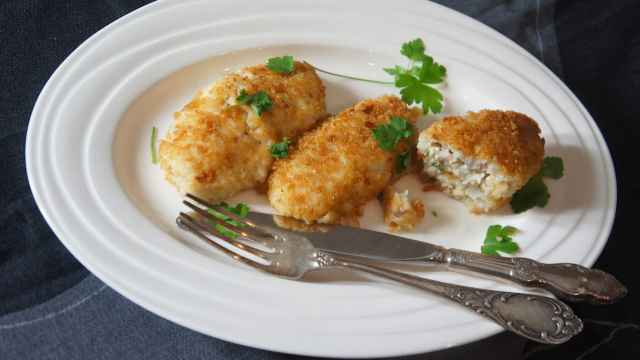In Russia, almost every day is a holiday. In addition to public holidays such as Victory Day and New Year’s Day, Russians also annually celebrate over 400 professional holidays.
January 31 is the official Birthday of Russian Vodka, the day on which Dmitry Mendeleyev defended his doctoral dissertation “On Combining Water and Alcohol” in 1865. In his dissertation, he continued his exploration of chemistry, a study that would see Mendeleyev four years later publish his groundbreaking Periodic Table.
The Periodic Table established Mendeleyev as one of the leading scientists of his age, and honors were heaped upon him. He served the Imperial Government as Director of the Bureau of Weights and Measures, and it was this job that got Mendeleyev into the vodka business. Legend has it that in 1894 Tsar Nicholas II ordered Mendeleyev to create a standard recipe for Russian vodka. Mendeleyev supposedly simply rounded up his dissertation number of 38 percent alcohol to a more marketable 40 percent (80 proof), the number still in use today.
Mendeleyev’s actual participation in the vodka recipe was probably far more minor than the legend purports, but the marketing people are still using it to great effect in the brand building of modern labels such as Russian Standard.
Russian vodka, of course, dates much further back than 1894, though not, perhaps, as far as we might imagine, just as vodka is not as Russian as we might like. Poles were distilling grain and potato spirits from the 8th century, but Russians encountered distilled spirits only in the late fourteenth-century, when Genoese merchants passed through Muscovy en route to Lithuania with a fiery grappa-like liquor they called “aqua vitae.”
Historians recount that the Muscovites didn’t think much of it. Aqua vitae, they agreed, might make a good medicine — topical or internal — if one were truly ill, but for drinking, they preferred their own, more labor-intensive home-brewed mead and beer.
It would take another century before monks in the Chudov Monastery in the Kremlin began to master the art of distilling grain alcohol. They found a savvy patron in Tsar Ivan III, who recognized in vodka a partial solution to his need to fill the national coffers. He instituted the first state monopoly of vodka in 1472, inaugurating a five hundred year tug-of-war between the state and its thirsty citizens over vodka’s price, quality, quantity, access, and distribution.
High vodka prices and restrictions on access to it often led to civil unrest in the uneasy sixteenth-century Time of Troubles. Russian nobles were granted the right to distill their own vodka on their estates by Catherine the Great, a nice perk they enjoyed for over 100 years, until the Abolition of Serfdom in 1861 paved the way for more commercially-minded vodka merchants such as Pyotr Smirnoff, who focused on making a purer version of vodka in safer working conditions, mindful of the concern that home-brew was known as a leading cause of illness and death among the lower classes. This is the era of Mendeleyev and his legendary 40 percent.
When Revolution came in 1917, it did little to curb the national thirst for vodka. Production, distribution, and sales were nationalized by the government. Vodka remained the cornerstone of every hatching, matching, or dispatching, and all the celebration in between. And so it is today!
Vodka in Russia is most often taken neat, ideally chilled, but temperature is never a deal breaker! The best pairing for vodka, Russians believe, is bread: it is customary to take a big sniff of aromatic Russian bread after a shot of vodka. Some folklorists claim that it is the spirit of the bread’s grain, helping the spirit of the vodka’s grain to guide the beverage down one’s throat. I’m not sure that’s true, but I do know this: it’s not a great idea to consume a lot of vodka on an empty stomach.
That’s where zakuski (appetizers) come in.
Russian zakuski can be as humble as that Holy Trinity of Russian snacks: half a loaf of dark bread, a jar of pickles, and a few slices of pork fat, called “salo.” But zakuski can also be that groaning table of platters of smoked fish, salads with rich mayonnaise and sour cream dressing, piping hot juliennes, smoked sausages and cheese, fresh herbs, and exotic delicacies from the Former Soviet Union.For Russian Vodka Day, I’ve come up with a tasting menu that combines some updated versions of the classic zakuski line-up to act as “blotting paper” for an array of infused vodkas and vodka cocktails.
“Happy Birthday, Russian Vodka!” Tasting Menu
- Signature Cocktail: The 40 Percent
- Tarragon-infused Vodka
- Ginger-infused Vodka
- Caraway-infused Vodka
- Cranberry Rosemary Liqueur
- Marinated Brynza
- Smoked Fish and Charcuterie Platter
- Pickled Vegetable Platter
- Mushroom Julienne
Signature Cocktail: “The 40 Percent”
Ingredients:
75 grams of the finest Russian vodka, well chilled
- Pour the vodka into a frosted glass.
- Say a toast.
- Toss back in one dramatic gesture.
- Repeat throughout the evening.
Vodka Infusions: The Frazzled Hostess’s New Best Friend
Vodka infusions represent one of the best effort-to-output ratios around. After you combine the flavor and the vodka and shake it a bit, you basically walk away for the allotted time, then come back, decant your product into a suitably retro bottle, and serve it to wild appreciation.
Infusing is simple, but it is important to follow a few basic housekeeping rules:
1. Be a Small Batch Infuser:
Home-infused vodkas have a much fresher taste than their commercially produced counterparts, but they won’t last nearly as long. Don’t go overboard and make barrels of infused vodka that will only spoil before you have time to consume them.
2. Don’t use the cheapest vodka
There is a school of thought that you can use really cheap vodka for infusions, but this is not the case: cheap vodka should be reserved for de-icing your windshield. Infusions work best when the vodka is odorless and flavorless, and that involves a modest outlay of funds. There is no need to splash out on Grey Goose, but choose a middle range bottle that has a label you recognize!
3. Hygiene, Hygiene, Hygiene!
Begin by washing your hands thoroughly with hot water and soap. Use wide-mouth jars to infuse your vodka — later you can decant the result into a lovely bottle, but during this stage you don’t want to be struggling to get things in and out of narrow necked bottles.
Wash and sterilize the jars in a dishwasher on its highest temperature or by scrubbing it thoroughly with dishwashing liquid, rinsing, then pouring hot water into the jar. Don’t forget to sterilize the lids as well!
Prep your fruit and herbs carefully. Make sure that berries and fruit are ripe with stems, seeds, and pits removed. Discard any rotten fruit. Wash gently with cool water air dry in a colander. Make sure that all the herbs you use have been carefully washed and drained so that any grit is removed. (For best results, use a salad spinner). Woody herbs such as the rosemary and tarragon we use in this menu need to be pruned of their twig-like bases.
4. Proportions and Time
Infusion is not an exact science, and you will need to experiment with time and proportion to arrive at your own signature infusion. I recommend beginning with 2 cup/450 ml batches of vodka that you infuse for 3-4 days in a cool dark place unless instructions indicate otherwise.
5. The Method
After you combine the fruit, berries, herbs, or spices with the vodka and securely fasten an airtight lid on your jar, shake the jar gently to combine the flavors. Store the jar in a cool, dark place such as a pantry. Each day, give the jar a shake. After three days, taste the mixture for intensity of flavor. If you feel it needs more time, give it another day.
When you’ve determined that the infusion is ready, strain the mixture through either a fine mesh sieve, several layers of clean cheesecloth, or, in a pinch, a paper coffee filter such as Chemex. Discard the solids and decant your finished product into a presentation bottle. If you want to add herbs for decoration, introduce fresh ones before serving.
Vodka infusions prepared in this manner will last up to 3 days at room temperature.
Vodka Degustation
Tarragon-Infused Vodka
Ingredients:
2 bunches fresh tarragon, with the woody twig-like parts of the plant removed
2 cups (450 ml) vodka
Method Notes: Tarragon’s distinctive flavor works quickly. Begin to taste your infusion on Day 3; it will probably be ready!
Pairing Notes: Tarragon-infused vodka is a marvelous base for citrus-dominated cocktails such as a Collins. Combine with fresh lime or grapefruit juice and top with club soda. Tarkhun soda — that brilliant emerald soft drink — would make a fine mixer. Muddle fresh berries and cucumber and add the vodka for a refreshing drink with ice, topped with either Prosecco or fizzy water.
Ginger-Infused Vodka
Ingredients:
2 substantial knobs of fresh ginger peeled and sliced into thin “coins”
2 cups (450 ml) vodka
Pairing Notes: This infusion is lovely by itself; the ginger provides a refreshing tang to the vodka. It works very well in a hot toddy, and, it goes without saying, this is the one to reach for when you want a Moscow Mule!
Caraway-Infused vodka
Ingredients:
(30 ml) caraway seeds
2 cups (450 ml) vodka
1 Serrano chili pepper, sliced down the middle (optional — this provides more heat)
Method Notes: Toast the seeds to release their essential oils
1. Place the seeds in a very clean frying pan and toast them very gently until they begin to give off an intense odor. Watch them carefully and don’t let them scorch!
2. Remove the seeds to a clean plate and let cool completely before adding them to the clean jar. Pour the vodka over the seeds, cover and shake lightly to combine.
Pairing Notes: This is the basis of my version of Canada’s “Hail Caesar,” a Bloody Mary made with Clamato. The caraway seeds give it a sweet pungency that cuts through the clam juice. You either love it or you hate it...there’s no in between. Other excellent pairings are tonic and celery bitters with a wedge of grapefruit.
Vodka-Based Liqueurs
The method for making liqueurs differs slightly from that of infused vodka. Here, the fruit and herbs are mixed into a sugar syrup and combined with the vodka to steep. The sugar acts as a preservative, so the shelf life of these liqueurs is slightly longer: about 6 months refrigerated.
Cranberry & Rosemary Liqueur
This is a Yankee riff on my mother-in-law’s “klyukva” or cranberry cordial. It’s a showstopper at Thanksgiving, but equally welcome year round in Moscow as the base of a slightly improvised Cosmopolitan. I use brown Turbinado sugar, which darkens the color but gives it a richer taste. If you want the classic cranberry red, use white sugar.
Ingredients:
1 cup (250 ml) sugar
Zest of one lime (remove only the skin, not the bitter white pith underneath)
¾ cup (180 ml) water
1 cup (250 ml) fresh cranberries or currents
2 sprigs fresh rosemary stems, woody stumps of the stem removed.
1½ cups (350 ml) vodka
Instructions:
1. Sterilize a 2-liter jar with a wide mouth.
2. Bring the sugar, water, lime zest and cranberries to a boil in a heavy-bottomed saucepan.
3. Reduce heat and simmer until the cranberries begin to pop. Remove from the heat and set aside to cool to room temperature.
4. Pulse the cranberry mixture in food processor fitted with a steel blade or with a sturdy hand-held immersion blender until the cranberries begin to release their liquid.
5. Combine the cranberry mixture, vodka, and rosemary in the jar and shake gently to combine. Seal and store in a dark place at room temperature for 2-3 days. The longer it steeps, the more intense the flavor will become.
6. Strain the mixture through a fine mesh sieve and then through several layers of clean cheesecloth or a paper coffee filter. Discard the cranberry, lime zest, and rosemary stems.
7. Decant the liqueur into a decorative bottle,
This liqueur can be sipped on its own or used as the base of a cocktail. Adding ginger ale and fresh lime will make nice Cape Codder.
Fish and Meat Platters
When I first began frequenting Russian houses for long, boozy evenings, it always bothered me that the hostess spent so much time arranging delicious (and very hard to acquire) smoked sausages, cold cuts, and especially smoked fish in such elaborate patterns, only to have them dry out almost immediately. I have only to see a dried out end of a salami, a hardening lump of smoked salmon with lethal bones sticking out of it, and carefully sliced triangles of Borodinsky bread curling and hardening at their ends and I’m transported back to the bad old days of Russia in the 1990s.
It took me a long time to learn is that a zakuski table is as much about the visual as it is about the taste. Zakuski are a Russian hostess’ way of expressing that most cherished of Russian traits: generous and expansive hospitality. The best zakuski boards are expansive and varied, laid out in all their glory when the guests arrive. “Come in,” the zakuski should convey, “come in and stay for a long time. We’re glad you are here!”
Zakuski should also compliment the drink of choice for the evening. Since vodka is our focus, I’ve kept it fairly traditional, with a few tweaks and surprise introductions. Salty fish and spicy meats encourage more drinking, as do the tart pickles, while the Mushroom Julienne is sufficient to both line the stomach and satisfy any serious hunger.
My very rough calculation on these platters is 200-400 grams per person of the entire cold fish and meat platters. The fish platter should be served with plenty of fresh lemon wedges, a basket of thinly sliced brown and black breads and crackers. Replenish frequently to keep your fish cool and fresh.
• Smoked Salmon, sliced very thinly, served with dark bread, butter, sliced red onion, and capers.
• Herring rollmops (buy these already made, or make them yourself by rolling marinated herring fillets around very finely julienned pickles and onions.
• A Smoked Fish paté (combine flakes of an oily smoked fish such as mackerel or haddock with cream cheese, chopped dill, lemon juice, salt and pepper.) Chill until serving.
• Russian Cold Cuts & Cheese: The preserved meat section of the Russian market can seem as scary as it is unappealing, but it is all in the presentation. Get that garlic sosika home, slice it very thinly and arrange it on a platter and it is a whole different animal. Try peppery basturma, which is essentially pastrami; carbonat, which is ham’s Slavic cousin; and by all means, if you can, score a Georgian cheese and herb log. Serve these with Dijon mustard, even if the Russians will look at you in an odd sort of way.
After the 2014 food sanctions, I rediscovered my love of brynza, the sheep’s milk cheese that is a staple of the Balkans and adopted by the Russians as their own. Like its Greek cousin, feta, brynza’s tart, peppery taste makes a wonderful pairing with vegetables.
In recent years, I’ve been playing around with marinating brynza. Coupled with Russia’s beloved garlic-flavored sukhariki (toast), it makes a lovely opening salvo to a dinner party or a nice snack with drinks.
Marinated Brynza with Thyme
Ingredients:
⅔ lb. (300 g) brynza, cut into cubes
Best quality olive oil
1 tsp peppercorns
2 sprigs of fresh thyme
2 bay leaves
Instructions:
1. Sterilize a 400 ml glass container with an airtight lid.
2. Add one bay leaf, one sprig of thyme and the peppercorns to the glass container.
3. Add the brynza cubes to the jar, placing the remaining bay leaf and thyme on top.
4. Fill the jar with olive oil.
5. Refrigerate until serving, but let the jar come to room temperature before you serve.
6. Serve with crackers or a baguette. Roasted cherry tomatoes make a nice accompaniment, as do marinated cucumbers.
Mushroom Julienne
“Julienne” is one of those French cooking terms that has come to mean something quite different in Russian. Far from a neat pile of raw vegetables sliced into slender, uniform matchsticks, a Russian Julienne is a creamy au gratin: a confection of vegetables, fish, or meat baked with sour cream and a white sauce in small metal pots or ceramic ramekins, topped with melted cheese. At formal Russian meals, the Julienne is brought out after the cold zakuski have been consumed but before the main course is served.
I have very happy associations with Mushroom Julienne: it was always served to the tourist groups I led in the 1990s as part of their “Gala Farewell Dinner,” and it always went down a treat. No matter how watery the soups had been for the rest of the tour, or how surly the service, one taste of Mushroom Julienne and all was forgiven!
Juliennes are another great effort-to-output ratio dish, since they can be assembled ahead of time, needing only a quick trip into a hot oven, ideally one with a broiler. Although mushrooms are far and away the most popular ingredients of Julienne, combinations such as smoked salmon and leek or smoked trout and green peas are equally delicious. Served with some slices of crusty, chewy bread and a green salad, they can stand alone as lunch or dinner.
Mushroom Julienne
Ingredients:
3 Tbsp (30 ml) flour
2 Tbsp (30 ml) heavy cream
3 Tbsp (45 ml) butter plus extra to butter the ramekins
⅔-cup (156 ml) sour cream
1 lb. (450 grams) fresh mushrooms, cut into quarters
1 cup (250 ml) and ⅓-cup (80 ml) of Madeira, in separate containers
1 cup (250 ml) boiling water
6 oz. (150 grams) dried mushrooms
½ cup (120 ml) small bacon or pancetta lardons
1 medium-sized yellow onion roughly cut into 2 cm pieces
Salt and pepper to taste
½ tsp nutmeg
½ tsp cayenne pepper
1 pinch of paprika
¾ cup (180 ml) of a hard cheese such as Asiago or Parmesan, coarsely shredded. Gruyere also works, though the strong flavor can overpower the mushrooms.
1 Tbsp (15 ml) fresh thyme
Instructions:
1. Butter 4-6 ramekins (depending on size) and set aside.
2. Preheat the oven to 375ºF or, if your oven has a broiler function, use that, adjusting the rack to about 10 cm below the broiler.
3. Place the dried mushrooms in a non-reactive bowl. Pour the boiling water and 1 cup of Madeira over them. Press lightly on the mushrooms to submerge them. Cover and leave to steep at least 50 minutes.
4. Sauté the bacon lardons over low heat until the fat is rendered (about 20 minutes). Remove the lardons to a plate lined with paper towels and allow them to drain.
5. Add the onion to the pan and sauté gently until they are limp. Remove the onions from the pan.
6. While the onion and bacon are cooking, remove the rehydrated mushrooms from their liquid, and then carefully strain the liquid through a fine mesh sieve or layers of cheesecloth.
7. Add the fresh mushrooms to the pan with 1 Tbsp (15 ml) of butter and remaining Madeira. Sauté the mushrooms on low heat until they release their moisture, and then reabsorb it (approximately 18-20 minutes). Stir frequently. When the mushrooms are almost done, add the rehydrated mushrooms to the pan and toss gently to combine. Set aside.
8. In a small saucepan over medium heat, melt 2 Tbsp (30 ml) of butter until it is just bubbling. Add the flour, nutmeg, and cayenne pepper and use a whisk to combine into a paste. Lower the heat and cook for 2 minutes, whisking constantly.
9. Pour about ¼ of the mushroom liquid into the flour paste and whisk to combine. Then slowly add the remaining liquid, whisking continuously to ensure that there are no lumps. The mixture will thicken gradually, and when it coats the back of a spoon, fold in the heavy cream.
10. In a large bowl, toss the mushrooms, onion, thyme, and bacon together with the sauce and the sour cream. Taste the mixture and adjust seasoning. You may want to add salt and pepper at this stage.
11. Divide the mixture evenly between the buttered ramekins. Place the ramekins on a shallow cookie sheet and bake in the preheated oven for 10-15 minutes, until the mixture is bubbling. Top each ramekin with a handful of cheese, a pinch of paprika, and a grind of black pepper and return to the hot oven for another 5 minutes until the cheese turns golden brown.
12. Serve immediately with wedges of crusty bread. A crisp salad of peppery greens makes an excellent accompaniment.
The Pickle Platter
There is something about pickles and vodka that just go together. Each can hold its own, but together, you have a party! Which is why it is vital to get a pickle platter put together before you lose the ability to say that phrase ten times fast.
The best place to do this is a Russian farmers’ market. Simply put yourself in the capable hands of the sturdy women who will press upon you mountains of pickled cucumbers, cabbage, carrots, beets, apples, scallions, and whatever else they’ve got in the buckets.
If you are not near a Russian farmer’s market or the kind of hipster place where fermentation is all the rage, fear not! Here are the components of a great pickle platter. If your community has an International Supermarket, pop in to see if they carry Polish or Russian specialties. But if not, simply roam your supermarket aisles for inspiration. Pick up a variety of pickles, and then arrange them on a platter:
1 jar of best-quality kosher dill pickles
1 jar of sauerkraut, decanted into a decorative dish
1 jar of pickled or roasted peppers
1 jar of pickled beets
1 jar of best-quality olives
1 jar of homemade “quick pickles”
You can “quick pickle” anything, but my favorite combination is watermelon radishes with red onions. They add a nice peppery flavor to the pickle platter and look marvelous with their bright pink and purple colors.
Quick Pickles
Ingredients:
2 cloves garlic
2 bay leaves
3 Tbsp (45 ml) pickling spice
2 cups (450 ml) red wine vinegar
3 Tbsp (45 ml) kosher salt
1 large spoonful of good quality honey
2 watermelon radishes*, sliced as thinly as you can. If you have a Mandolin, this is a good time to put it to use!
1 small red onion, sliced as thinly as you can
Instructions:
1. Combine the vinegar, pickling spice, honey, garlic, salt, and bay leaves in a saucepan and bring to a simmer. Stir until the salt is completely dissolved.
2. Layer the sliced watermelon radishes and red onion into a clean glass jar with a wide mouth.
3. Pour the pickling liquid into the jar (if you don’t like picking your way through mustard seeds and whole allspice, then strain these out, but I think they enhance the look).
4. Put the lid on the jar and let sit on the counter until cooled to room temperature. Store in the refrigerator until you are ready to serve.
*Get creative with your quick pickles: try Jerusalem artichokes, thinly sliced cucumbers, chard stems, spiralized zucchini, wheels of roasted beets, and tart apples.
Jennifer Eremeeva is a longtime expat who writes about food, cuisine, history and travel at jennifereremeeva.com.
A Message from The Moscow Times:
Dear readers,
We are facing unprecedented challenges. Russia's Prosecutor General's Office has designated The Moscow Times as an "undesirable" organization, criminalizing our work and putting our staff at risk of prosecution. This follows our earlier unjust labeling as a "foreign agent."
These actions are direct attempts to silence independent journalism in Russia. The authorities claim our work "discredits the decisions of the Russian leadership." We see things differently: we strive to provide accurate, unbiased reporting on Russia.
We, the journalists of The Moscow Times, refuse to be silenced. But to continue our work, we need your help.
Your support, no matter how small, makes a world of difference. If you can, please support us monthly starting from just $2. It's quick to set up, and every contribution makes a significant impact.
By supporting The Moscow Times, you're defending open, independent journalism in the face of repression. Thank you for standing with us.
Remind me later.



